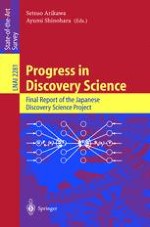2002 | Buch
Progress in Discovery Science
Final Report of the Japanese Dicsovery Science Project
herausgegeben von: Setsuo Arikawa, Ayumi Shinohara
Verlag: Springer Berlin Heidelberg
Buchreihe : Lecture Notes in Computer Science
Enthalten in: Professional Book Archive
